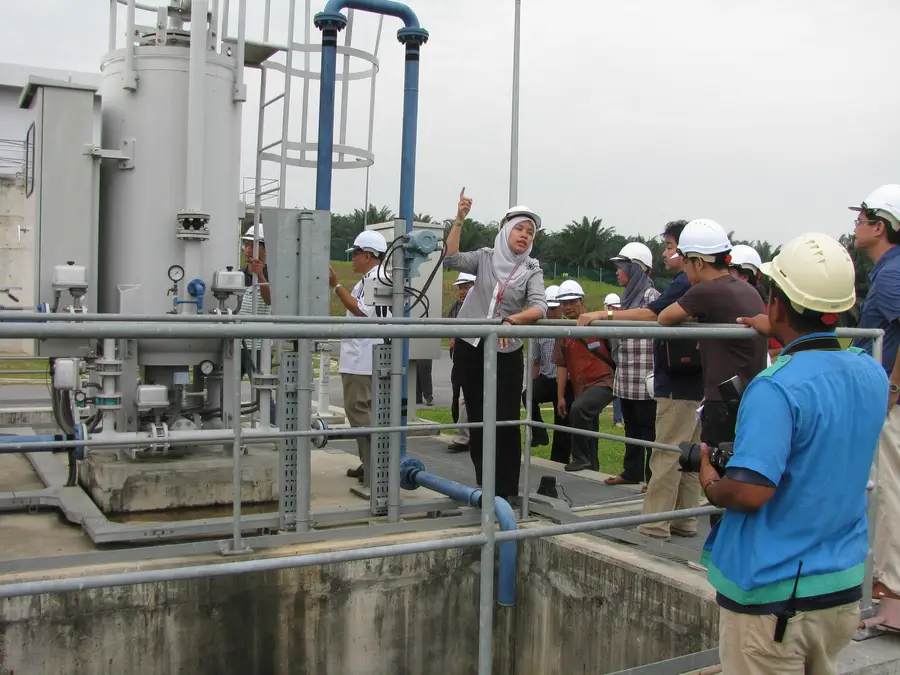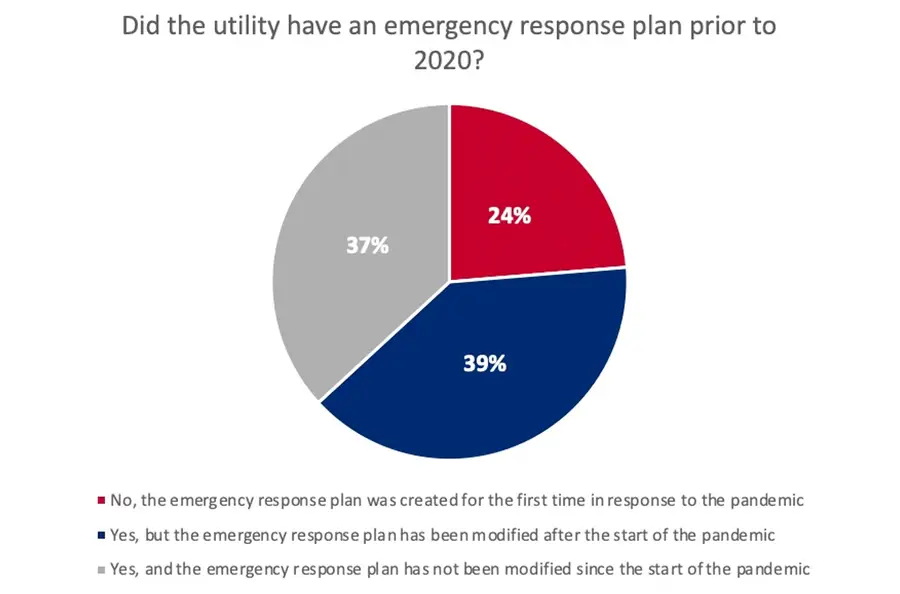
As the COVID-19 pandemic forced people into their homes and disrupted supply chains, a water utility in Lukanga, Zambia found itself with no good choice to make.
With fewer customers able to pay for water, the water supply company’s budget would only stretch to cover another month or two of operating expenses. Should it continue to pay the men and women who worked there? Or should it buy the chemicals it needed to deliver safe, treated water to people? There wasn’t enough to do both.
Water utilities around the world—especially medium-sized companies serving secondary cities and towns—struggled with tough decisions like these at a time when anxiety and uncertainty was already high. The truth is that many water utility companies are not resilient enough to coast through a major shock like a public health emergency, an extreme weather event or a natural disaster.
The truth is that many water utility companies are not resilient enough to coast through a major shock like a public health emergency, an extreme weather event or a natural disaster.
Part of our water sector governance and service delivery strengthening work focuses on building more resilient utility companies that are able to weather the storms—literal or figurative—thrown at them.
So, we embarked on an internally funded research project to understand the effects of the COVID-19 pandemic on medium-sized water utilities, and to help us learn which resilience capacities were most useful to them.
Our initial research findings from 52 utilities in eight countries across Southeast Asia, West and East Africa, and Central America are beginning to reveal which factors were the most protective during a time of unprecedented burden.
The pandemic's effects on the water sector: When ‘business as usual’ isn’t an option
Pre-COVID-19, many water supply companies were already attempting to increase water bill collection efficiency, enhance customer technology access, and maintain a skilled workforce. Covering operational expenses with limited capital set aside for investment was the norm. So, budgets felt the crunch almost immediately when the pandemic brought unprecedented business disruptions due to material supply chain discontinuity, increased workers’ safety requirements, and cash flow irregularities from deferred bill payments.
Meanwhile, governments in many areas mandated that utility companies stop disconnections for non-paying customers or halt debt collection efforts. Utilities also had to shift where the water was going; in some places, residential water usage soared as people stayed home, and overall use increased as residents dutifully washed their hands in 20-second bursts throughout the day.
Our research questions asked water utilities about their business continuity in the face of COVID: how well they were able to manage their finances, communicate with their customers, and keep the water flowing.
More demand and higher costs in the water supply industry
Nearly two-thirds of the utilities surveyed faced higher operational costs in 2020 as compared to the year before, as prices went up for inputs like power, chemicals, and maintenance equipment. On top of higher costs, a significant number of water supply companies also struggled with material shortages, delivery delays, and a lack of alternative suppliers, both domestic and international.
Although residential water consumption increased as stay-at-home orders began, over 40 percent of utilities reported decreased revenues, citing the loss of commercial customers’ demand for water, waived late payment fees, halted disconnections, and reduced collection efficiency.
To address the financial impact of the pandemic on the water supply industry, utilities we surveyed responded as best they could: by winnowing already lean budgets and eating into savings, mostly. Others went into overdraft status at their banks and requested higher lines of credit. Some utilities sought for national government subsidies and international assistance, turning to development partners for help.
Others cut wherever they could: office supplies, travel expenses, and overtime pay. That water utility in Zambia? The staff elected to delay their own salary payments so they could purchase chlorine to keep clean water running to their communities, still requiring additional grant assistance to do so.
Their decision speaks to these companies’ understanding that maintaining community engagement is paramount to building long-term resilience. Indeed, our research reflected the same finding: 65 percent of surveyed utilities increased their customer communications on key subjects like water supply continuity, bill payment delays, free water provision, and alternative bill payment methods.
The wake-up alarm we can’t afford to snooze
The water utilities we surveyed continue to cope with the financial and operational shocks dealt out by the pandemic. And—especially since climate change has made it certain that COVID-19 is not the last shock these utilities will face—we are using our water resource monitoring and forecasting tools and research to identify how building up resilience can mean the difference between buckling under the weight of disaster or bracing to face it.
Our work with water utilities overall has underscored the importance of building two kinds of resilience.
The first and more obvious one is the importance of building resilient facilities and infrastructure that can stand strong through events like hurricanes, cyclones, earthquakes, floods, and whatever other natural threats become more frequent and damaging as climate change affects our planet. This includes adopting more digital monitoring technologies, securing more water tanks to deliver water, and retrofitting or even moving infrastructure to safer locations.
But the second and more critical one —illustrated starkly by the disruptions wrought by COVID-19—is institutional resilience: the ability to maintain financial viability and business continuity when an emergency hits.
That means preparing business continuity plans and setting up lines of communication and coordination, maintaining customer relations, managing asset inventory, and making sure tools are in place to handle virtual payments and other technologies.
Utilities that didn’t have these things in place struggled; several surveyed utilities indicated that the pandemic made them rethink their existing emergency plans and re-evaluate risks such as worker safety protocols and supply chain management. Some who were caught without these kinds of plans felt the pandemic had served as a wake-up call to make them for next time.
But almost all the utilities we surveyed did have elements of institutional resilience that enabled them to handle the shocks inherent in the global pandemic and remain financially strong.
Only two water supply companies reported needing to lay off staff to manage their financial challenges, and two-thirds of respondents still managed to turn a profit in 2020. (Of the ones that didn’t, 63 percent were also in the red in 2019, suggesting their financial challenges were not solely related to COVID-19.)
And interestingly, 45 percent of utilities overall actually increased their profits compared to 2019, indicating that government policies that protect consumers’ access to water, even if they can’t pay, don’t have to be a financial death sentence for utilities.
Building resilience where it matters most
In the coming months, we’ll further explore our data to see what contributed most directly to institutional resilience. For instance, how did utilities in Nigeria that are part of USAID’s Effective Water, Sanitation and Hygiene Services (E-WASH) project fare? Through that program, our team has been working to integrate database software that puts a utility’s billing, collection, and asset inventory information in one management system.
Were utilities using this tool better able to carry out service provision, billing, and customer communication during shut-downs and quarantines? Did having robust and resilient technology and a plan for its emergency deployment make it more likely a utility could avoid cutting staff or digging deeper into savings beyond operational expenditures?
Our research should also allow us to answer questions about that pivotal customer engagement piece. Though we did not survey utilities in Senegal, the USAID-funded Governance for Local Development (GoLD) Activity continued its work during COVID-19 to shift the governance dynamics among local authorities and citizens, allowing for greater public advocacy and government transparency, including in WASH. We’ll be eager to compare experiences and results to see what happens when water utilities include stakeholders in service improvement and resilience planning.
Understanding what practices and technologies helped water utilities maintain business continuity during COVID-19 will also help shape resilience-focused projects moving forward into a changing climate. But perhaps more importantly, it will allow utilities to learn from one another what they need to do to prepare themselves for next time. Few among us could have predicted a shock like the COVID-19 pandemic, but all of us can look ahead and know how important it is to plan for the next one.
Stay tuned over the next few months as we share more findings and analysis from this research.


